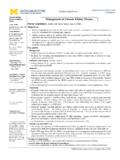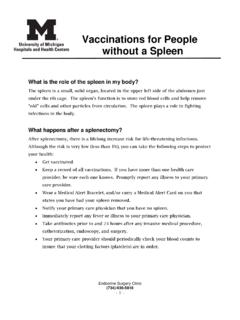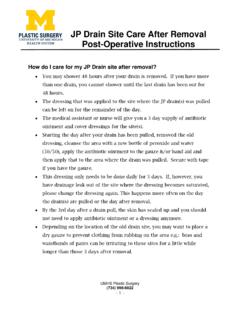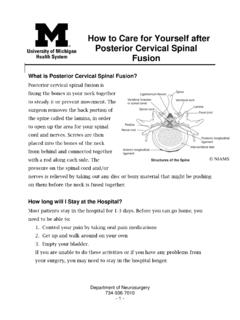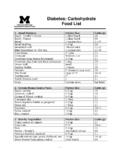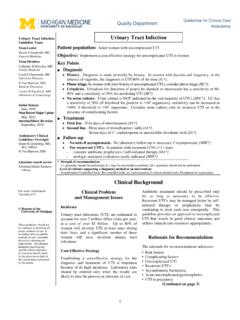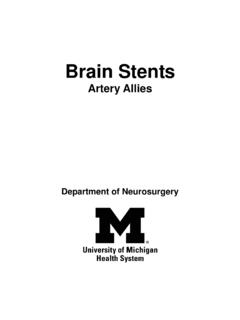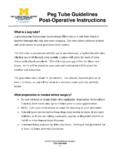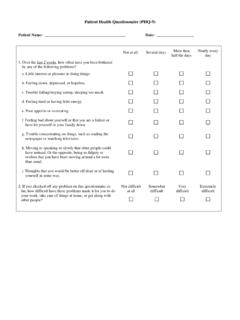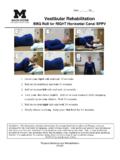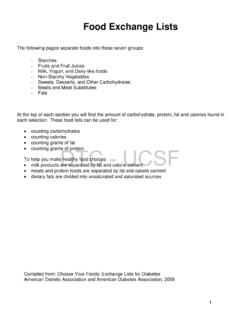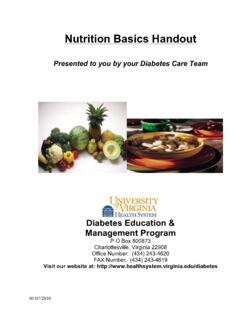Transcription of Gastroparesis Nutrition Therapy
1 Division of Gastroenterology -1- Gastroparesis Nutrition Therapy Gastroparesis , also called delayed gastric emptying, is a disorder that slows or stops the movement of food from the stomach to the small intestine. Common symptoms of Gastroparesis include: Nausea or a feeling of fullness after eating only a small amount of food Vomiting undigested food, sometimes several hours after a meal Gastroesophageal reflux (GERD) Abdominal pain Bloating Lack of appetite The severity of Gastroparesis varies from person to person. It is important to find what works best for you. Keep in mind Gastroparesis is not a static condition, meaning your symptoms can vary from week-to-week or even day-to-day.
2 During a Gastroparesis flare you may experience a period of time where all you can take is liquids. What and how you eat can influence your symptoms. There are various dietary modifications you can use to help manage your symptoms and ensure you are receiving all the nutrients your body needs. Nutrition recommendations: Pay attention to portion sizes Avoid eating large meals as this will take longer to empty from your stomach and can increase symptoms. Eating smaller, more frequent meals and snacks can help you feel better and also help you consume enough nutrients throughout the day.
3 Division of Gastroenterology Gastroparesis Nutrition Therapy -2- Avoid snacking or grazing and give yourself time to digest your food. Grazing all day can lead to overeating and reduce your appetite. Try spacing meals and snacks out by at least 3 hours if feasible. Based on your portion sizes and calorie needs you may need to eat 4-6 smaller meals per day. What does a small meal look like? Aim for about 1 to cups of food per sitting. The size of the meal and timing may need to be adjusted based on your specific tolerance. Experiment with solid vs liquid meals When solid foods are not going well, it may be necessary to consume all or mostly liquids.
4 Use oral supplements, homemade shakes and smoothies, protein powders, fruit juices, soups, broths, popsicles, milk and plant-based milks o Oral supplements: Boost Simply Complete, Ensure Original/Plus/Clear, Orgain, Carnation Instant Breakfast Most foods can be pureed in a blender. Timing of meals: Solids may be better tolerated earlier in the day. If so, try pureed foods or a shake/smoothie later in the day. Or if you experience nausea early in the day, you may find that liquids or soft foods work best to get your day started. Reduce dietary fat High fat meals take longer to empty from the stomach than low fat meals.
5 Important: A lower fat diet does not mean you need to eat a fat free diet. In general, 40 grams of fat per day is well tolerated. Like all guidelines, this varies from person to person and you may need to decrease this to Division of Gastroenterology Gastroparesis Nutrition Therapy -3- 30 grams (especially during flares) or you may be able to tolerate around 50 grams of fat per day without worsening symptoms. Liquid beverages with fat are easier to tolerate than solid fats. o Examples: 2% or whole milk, soy milk, or oral supplements. Avoid fried foods and high-fat meats such as bacon, hot dogs, salami, bologna, and sausage.
6 Healthier fat sources (to use in moderation): o Olive oil, coconut oil, Earth Balance, creamy nut/seed butters, avocado, whole eggs, ground meats, fatty fish, and full fat dairy products. Spread fat intake throughout the day by having a small amount at all meals and snacks. Avoid high fiber foods High fiber foods can increase the time it takes to empty the stomach. Tolerance to fiber varies, but 10-12 grams per day (or 2-3 grams per meal) is a good place to start. Fiber is found in beans, peas, whole grains, fruits, vegetables, nuts, and seeds. To make fruits and vegetables easier to tolerate: o Peel off thick skins o Cook vegetables (and fruit if needed) until fork-tender.
7 The softer the consistency the easier it will be to digest. o Limit fruit and vegetables to cup per meal or snack (can increase portion as tolerated) o Blend fruit into a smoothie or try canned fruit / fruit squeeze pouches Choose refined grains instead of whole grains (Example: white rice vs brown rice) Select creamy nut butters versus crunchy. Division of Gastroenterology Gastroparesis Nutrition Therapy -4- Fill up on nutritious foods first Make nutritious foods a priority before filling up on things like candy, soda, chips, etc. For a well-balanced meal, include a source of carbohydrate, protein, and a small amount of healthy fat.
8 Chew foods thoroughly Digestion starts in the mouth, chewing your food well reduces the amount of work your stomach has to do. Stay hydrated Drink adequate fluids during the day to meet hydration needs. If vomiting, sip on Pedialyte or Gatorade to replace electrolytes. Don t drink too much during a meal as this may fill up your stomach too quickly. Limit to cup (4oz) of fluids with meals and wait 30 minutes after eating to continue drinking. Lifestyle and kitchen tips: A blender and crockpot are helpful kitchen appliances that can be used to make Gastroparesis friendly meals such as soups, shakes, smoothies, tender cooked meats, fruits, and vegetables.
9 Use measuring cups to help with portion sizes. Use nutrient-rich liquid supplements or homemade shakes in your diet as needed to reduce symptoms and/or to get enough calories. Feeling nauseous? Try using ginger to alleviate nausea. o Ginger tea, ginger chews (such as Gin-Gins), fresh ginger added to smoothies, cooking with powdered or fresh ginger Avoid laying down for 3 hours after eating. Gravity helps your stomach empty so it is recommended to sit or stand up-right after eating. Division of Gastroenterology Gastroparesis Nutrition Therapy -5- Try light walking for 15-30 minutes following a meal to stimulate your stomach.
10 What are bezoars? Bezoars are hardened masses of undigested fiber than can collect in the stomach causing severe symptoms. Foods that cannot be chewed fully or that are indigestible by your stomach may contribute to bezoar formation. If you experience a bezoar, you are more likely to have another. Foods to avoid that may cause bezoar formation: Apples (w/peel) Berries (large amounts) Brussels sprouts Cabbage Celery Coconut Corn Dried fruit /Raisins Figs Legumes & Peas Nuts & Seeds (in whole form) Oranges Persimmons Sauerkraut String beans Skins of fruits & vegetables (potato, grape, plum, etc.)
